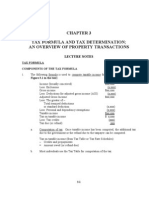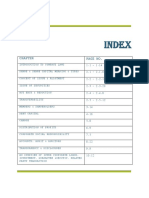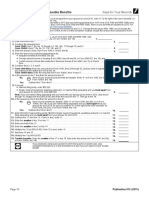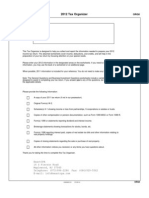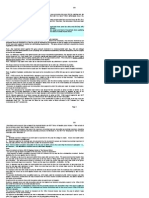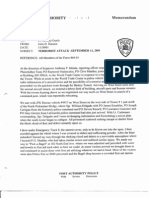Current Concepts: Review Article
Current Concepts: Review Article
Uploaded by
Mia Mia MiaCopyright:
Available Formats
Current Concepts: Review Article
Current Concepts: Review Article
Uploaded by
Mia Mia MiaOriginal Title
Copyright
Available Formats
Share this document
Did you find this document useful?
Is this content inappropriate?
Copyright:
Available Formats
Current Concepts: Review Article
Current Concepts: Review Article
Uploaded by
Mia Mia MiaCopyright:
Available Formats
The Ne w E n g l a nd Jo u r n a l o f Me d ic i ne
Review Article
Current Concepts
T INNITUS
ALAN H. LOCKWOOD, M.D., RICHARD J. SALVI, PH.D., AND ROBERT F. BURKARD, PH.D.
INNITUS is a common yet poorly understood disorder. Data from the National Center for Health Statistics show that tinnitus is more common in men than women and increases in prevalence with advancing age (Fig. 1). It is frequently associated with hearing impairment.1 Almost 12 percent of men who are 65 to 74 years of age are affected. Whites are more frequently affected than blacks, and the prevalence in the South is almost twice that in the Northeast.1 Tinnitus may be present in children, although they rarely make this symptom known.2 Many patients with tinnitus believe that they have a serious medical problem. This is rarely the case. Most treatments are unsuccessful, and attempts to develop evidence-based therapies have been thwarted by a poor understanding of the pathophysiology of tinnitus. In spite of these limitations, in many cases, tinnitus can be managed satisfactorily. The successful approach to the patient with tinnitus begins by differentiating objective from subjective tinnitus (Table 1). The failure to make this distinction may lead to diagnostic and management errors. Patients with objective tinnitus are hearing real sounds. Pulsatile sounds are reported by about 4 percent of unselected patients with tinnitus3 and are usually caused by vibrations from turbulent blood flow that reach the cochlea. An astute observer will link the rhythm of the pulsations, which may be heard on auscultation, to the cardiac cycle. Some causes of pulsatile tinnitus are listed in Table 1. A history taking and physical examination, followed by neuroradiologic
From the Veterans Affairs Western New York Healthcare System (A.H.L.); the Departments of Neurology (A.H.L., R.J.S.) and Communicative Disorders and Sciences (A.H.L., R.J.S., R.F.B.) and the Center for Hearing and Deafness (A.H.L., R.J.S., R.F.B.), University at Buffalo; and the Mabie Laboratory, Center for Positron Emission Tomography, University at Buffalo and Veterans Affairs Western New York Healthcare System (A.H.L., R.J.S., R.F.B.) all in Buffalo, N.Y. Address reprint requests to Dr. Lockwood at the Center for PET (115P), VA Western NY Healthcare System, 3495 Bailey Ave., Buffalo, NY 14215, or at alan@petnet.buffalo.edu.
imaging, may identify a treatable cause.4 Clicking or low-pitched buzzing may indicate palatal myoclonus or contractions of the tensor tympani or stapedius muscle.5 Occasionally, spontaneous vibrations of the outer hair cells of the cochlea may produce audible sounds known as spontaneous otoacoustic emissions. Such sounds are common but are rarely perceived.6 The detection of spontaneous otoacoustic emissions requires special equipment and may not be included in a routine audiologic examination. Subjective tinnitus, which we refer to as tinnitus, is the false perception of sound in the absence of an acoustic stimulus. Common causes are listed in Ta-
120 100 80 60 40 20 0
Prevalence of Tinnitus (per 1000)
Women Men
< 45 yr
4564 yr
6574 yr
75 yr
Age
B 500 400 300 200 100 0 < 45 yr 4564 yr 6574 yr 75 yr
Women Men
Prevalence of Hearing Impairment (per 1000)
Age
Figure 1. The Prevalence of Tinnitus (Panel A) and Hearing Impairment (Panel B). Values are based on responses to the question Do you have tinnitus or ringing in the ears [or] deafness [or] other trouble hearing? included in the National Center for Health Statistics survey of noninstitutionalized Americans.1
904 N Engl J Med, Vol. 347, No. 12 September 19, 2002 www.nejm.org
Downloaded from www.nejm.org on September 15, 2005 . This article is being provided free of charge for use in Indonesia. Copyright 2002 Massachusetts Medical Society. All rights reserved.
CURRENT CONCEPTS
TABLE 1. CAUSES
TYPE
OF
SUBJECTIVE
AND
OBJECTIVE TINNITUS.
CAUSES
Subjective tinnitus Otologic Neurologic Infectious Drug-related Other Objective tinnitus Pulsatile
Noise-induced hearing loss, presbycusis, otosclerosis, otitis, impacted cerumen, sudden deafness, Menieres disease, and other causes of hearing loss Head injury, whiplash, multiple sclerosis, vestibular schwannoma (commonly called an acoustic neuroma) or other cerebellarpontine-angle tumors Otitis media and sequelae of Lyme disease, meningitis, syphilis, and other infectious or inflammatory processes that affect hearing Common side effect of many drugs, such as salicylates, nonsteroidal antiinflammatory drugs, aminoglycoside antibiotics, loop diuretics, and chemotherapy agents (e.g., platins and vincristine) Temporomandibular-joint dysfunction and other dental disorders
Carotid stenosis, arteriovenous malformations, other vascular anomalies, vascular tumors (e.g., of the glomus jugulare), valvular heart disease (usually aortic stenosis), states of high cardiac output (anemia and druginduced high output), and other conditions causing turbulent blood flow Muscular or anatomical Palatal myoclonus, spasm of stapedius or tensor tympani muscle, patulous eustachian tube Spontaneous Spontaneous otoacoustic emissions
ble 1. Many people have episodes of tinnitus that last seconds or minutes or are transient and associated with exposure to loud sounds or drugs such as aspirin. These people rarely seek medical attention. In a series of more than 500 patients, a mean (SD) of 5.48.6 years elapsed between the onset of symptoms and a request for medical attention.3 At that time, 60 percent thought they had a serious problem and 55 percent thought they might become deaf.3 In this same group, 22 percent reported that the sounds were equal in both ears, 34 percent reported having unilateral sounds, and most of the others reported a lateral dominance.3 Lateralized tinnitus is common and rarely a sign of a tumor. Sounds were most commonly described as ringing (by 37.5 percent of patients), buzzing (by 11.2 percent), cricket-like (by 8.5 percent), hissing (by 7.8 percent), whistling (by 6.6 percent), and humming (by 5.3 percent).3 Most of these patients reported a high pitch, and 34 percent said that their tinnitus rated 8 or higher on a 10-point loudness scale, on which 10 was very loud.3 Reliable, objective measures of the loudness and pitch of tinnitus are difficult to obtain.7 In spite of patients perception that the sounds were loud, hearing tests showed that the sounds occurred at intensities that were just barely greater than the softest sound audible at that frequency.8 Pitch-matching studies generally show that the pitch of tinnitus corresponds to the frequency at which hearing loss becomes clinically significant (typically above 3000 Hz).8
CLINICAL APPROACH
The use of a systematic approach to patients, depicted in Figure 2, should help clinicians avoid errors
resulting from a failure to separate objective from subjective tinnitus, identify treatable disorders (such as those listed in Table 1), protect hearing, and treat associated problems such as depression, anxiety, and insomnia. Successful management and a high level of satisfaction on the part of patients are likely to follow a thorough evaluation in which sufficient time is allowed to develop a strong therapeutic relationship. Since tinnitus is usually a subjective phenomenon, the patients history and findings on physical examination are particularly important to differentiate objective from subjective tinnitus. A clear description of the sound the patient hears is critical and can be elicited by having the patient answer the following questions: Is the sound constant or episodic, unilateral or bilateral? Was the onset sudden or gradual? How long has it been present? What are the pitch and loudness of the sound? Is there associated hearing loss, vertigo, or pain? Is there evidence of other conditions (listed in Table 1) that are associated with tinnitus? (There is a strong correlation between tinnitus and temporomandibular-joint and other craniomandibular disorders.9-11) What else affects tinnitus background noise, alcohol, stress, or sleeplessness? Is there a history of exposure to loud noise, ear infections, otologic surgery, head injuries, and use of ototoxic drugs? Are there any side effects of tinnitus? How does tinnitus affect daily life and the ability to function? The physical examination should focus on the head and neck and include a careful inspection of the oral cavity, outer ear, tympanic membranes, cranial nerves (particularly the fifth, seventh, and eighth), and temporomandibular joint and auscultation of the heart, carotid arteries, and periaural region. Clinicians should
N Engl J Med, Vol. 347, No. 12 September 19, 2002 www.nejm.org 905
Downloaded from www.nejm.org on September 15, 2005 . This article is being provided free of charge for use in Indonesia. Copyright 2002 Massachusetts Medical Society. All rights reserved.
The Ne w E n g l a nd Jo u r n a l o f Me d ic i ne
Evaluation of patient with tinnitus
Characterize the sound and the patients quality of life; determine whether there is a history of hearing loss and exposure to noise and ototoxic drugs; perform neurologic and otologic examinations.
Differential diagnosis
Subjective tinnitus
Objective tinnitus
Prevent (further) hearing loss from exposure to noise and drugs.
Evaluate the effect of tinnitus on the quality of life.
Conduct audiologic tests for hearing loss and masking and to identify the site of any lesion.
If a pulsatile or retrocochlear lesion is present, perform a radiologic evaluation for vascular abnormalities, tumors, or other lesions.
If the effect is small, educate and reassure the patient about his or her condition and stress that no specific therapy is necessary.
If the effect is great, educate the patient about treatment options and evaluate and treat the patient for depression and anxiety, personality, or sleep disorders.
Consider therapy, such as the use of masking devices, tinnitus retraining or cognitive therapy, drugs, and complementary or alternative therapies.
If a cochlear lesion is identified, radiologic tests are not needed. Instead, consider the need for a hearing aid and aural rehabilitation.
Figure 2. An Algorithm for the Evaluation of Patients with Tinnitus. This approach is based on differentiating objective from subjective tinnitus; planned, focused laboratory testing, including audiometry to differentiate cochlear from retrocochlear lesions; education to preserve patients hearing; and an assessment of the effect of tinnitus on the quality of daily life as a guide to further interventions. Patients with retrocochlear lesions or objective tinnitus may require referral to a specialist, additional audiometric testing, or both.
906 N Engl J Med, Vol. 347, No. 12 September 19, 2002 www.nejm.org
Downloaded from www.nejm.org on September 15, 2005 . This article is being provided free of charge for use in Indonesia. Copyright 2002 Massachusetts Medical Society. All rights reserved.
CURRENT CONCEPTS
attempt to associate periodic sounds with the patients pulse or palatal movements. After specific questioning and manipulations, up to 75 percent of patients with tinnitus indicate that various maneuvers, such as clenching their jaw, cranial pressure, and eye movements affect the loudness of their tinnitus.12-14 As shown in Table 1, tinnitus is frequently a symptom of an associated disease process. Although treatment of the disease may not relieve tinnitus, an accurate diagnosis and treatment are important to prevent additional disability. Common conditions associated with subjective tinnitus that may require treatment include impacted cerumen, otitis media and other infectious or inflammatory conditions that affect hearing, Menieres disease (associated with low-pitched tinnitus), and otosclerosis. Drug-induced tinnitus may disappear after the offending agent is discontinued. As with other medical conditions, the laboratory tests ordered depend on the results of an analysis of the patients history and the findings on physical examination. Patients with pulsatile tinnitus should be evaluated for disorders that cause a high cardiac output (e.g., anemia and hyperthyroidism), valvular heart disease (especially disease of the aortic valve), and occlusive cerebrovascular disease (particularly among patients with risk factors for atherosclerosis). A comprehensive audiologic evaluation is essential. To quantify any hearing loss and identify any treatable conductive component of hearing loss, the test battery should include pure-tone thresholds (air and bone conduction), measures of acoustic impedance (tympanometry, acoustic-reflex thresholds), speech audiometry, and tests for maskability. Unilateral high-frequency hearing loss combined with poor speech discrimination suggests the possibility of a tumor, usually a vestibular schwannoma (commonly called an acoustic neuroma) or a meningioma. Patients with these findings must undergo additional tests to locate the lesion, such as tests of auditory brain-stem evoked responses, tone decay, reflex decay, and measures of vestibular function. Bilateral schwannomas may occur in patients with neurofibromatosis type 2. When indicated by audiometric tests, magnetic resonance imaging with gadolinium enhancement should be obtained.4 Patients with audiologic evidence of cochlear damage rarely require radiologic evaluations, since the results seldom affect the approach to management. The exact prevalence of hearing loss among patients with tinnitus is high but difficult to determine. Among patients with normal hearing, typically defined as audiometric (or hearing-level) thresholds that are 20 to 25 dB or less at frequencies ranging from 250 to 8000 Hz, it is likely that many once had better hearing or have impairments at frequencies higher than 8000 Hz. Further hearing loss must be avoided. Since expo-
sure to noise is a common cause of hearing loss, all sources of noise exposure should be reviewed. Although regulations of the Occupational Safety and Health Administration limit the level of noise exposure in most workplaces, regulations do not apply to all work areas, and additional ear protection may be advisable. Personal listening devices, appliances, and power tools are sources of noise that could cause or exacerbate hearing loss. A wide variety of hearing protectors is available. The choice should be based on the intensity of ambient sounds and occupational or other demands. For example, farmers (whose workplaces are not covered by Occupational Safety and Health Administration regulations) may require earmuff-like devices when they operate machinery, whereas orchestra musicians should be provided with custom-molded devices that fit into the external auditory meatus and are designed to attenuate sounds evenly across a broad range of frequencies. Patients with tinnitus should be instructed to inquire about all otologic side effects of any new drugs that are prescribed. It is important to evaluate the effect of tinnitus on daily life. Surprisingly, the perceived severity of tinnitus is unrelated to measurements of its loudness or pitch.8 Thus, other methods are required to assess the effect of tinnitus, and questionnaires have been developed for this purpose.15 The effect of tinnitus is greatest in patients who report physical immobility, sleeplessness, and pain and among those who are depressed or irritable, who are socially isolated, or who have psychiatric symptoms.16 Treating these problems may reduce the effect of tinnitus, even though the percept is unchanged.16,17
PATHOPHYSIOLOGY
The high incidence of cochlear damage led many to suggest that tinnitus arises in this organ.18,19 However, an origin in the central nervous system is implied by the observation of tinnitus in patients with complete transections of the auditory nerve. Functionalimaging studies of three disparate groups of patients support the central-origin hypothesis, as illustrated in Figure 3.12,20,21 Hearing loss leads to a reorganization of the pathways in the central auditory system.12,20,22,23 These changes may occur rapidly24 and lead to abnormal interactions between auditory and other central pathways.20 Analogous changes in the somatosensory system linked to phantom pain 25 led us to suggest that there are similarities between neuropathic pain and tinnitus.12 In patients with gaze-evoked tinnitus, lateral eye movements fail to produce the inhibition of the auditory cortex observed in controls.20 The absence of this phenomenon, called cross-modal inhibition, may contribute to the false perception of sounds. Levine hypothesized that a reduction in auditory-
N Engl J Med, Vol. 347, No. 12 September 19, 2002 www.nejm.org 907
Downloaded from www.nejm.org on September 15, 2005 . This article is being provided free of charge for use in Indonesia. Copyright 2002 Massachusetts Medical Society. All rights reserved.
The Ne w E n g l a nd Jo u r n a l o f Me d ic i ne
nerve input leads to disinhibition of the dorsal cochlear nucleus and an increase in spontaneous activity in the central auditory system, which is experienced as tinnitus.26 This mechanism could explain the temporary ringing sensation that may follow exposure to noise,27 the effects of some drugs such as furosemide, and spontaneous tinnitus in people with normal hearing who are placed in total silence.28 Other drugs, such as aspirin, increase the spontaneous firing rate of the auditory nerve.29 The complexity of the changes in the nervous system associated with tinnitus may explain why it is so resistant to treatment.
THERAPY
Many drugs produce tinnitus (a list is available at http://www.hearusa.com), but despite numerous trials, no drugs have been approved by the Food and Drug Administration for the treatment of tinnitus. Many trials have been criticized because of deficiencies in design, including the lack of appropriate controls, inappropriate randomization procedures, and poor choices of end points. In his review of 69 randomized clinical trials, Dobie concluded that no treatment can yet be considered well established in terms of providing replicable long-term reduction of
A Sagittal
B Coronal
y=32 mm
y=38 mm
y=48 mm
Figure 3. Neural Sites That Mediate Tinnitus. Positron-emission tomography shows foci of neural activity in auditory cortical sites in the temporal lobe from a group of patients with tinnitus perceived in the right ear. The unilaterality of the sites suggests a central origin of tinnitus, since real sounds presented to the right ear activated bilateral auditory cortical sites. In Panels A and B, the sites of activation are projected onto coronal and sagittal planes. The arrows on the sagittal projection in Panel A identify the locations of the coronal planes shown in Panel C. In the coronal planes, the colored foci of activation are superimposed on spatially averaged magnetic resonance images. The y values represent the distance of each site from the plane of the anterior commissure. Data are from Lockwood et al.12 Additional methodologic details have been published elsewhere.20
908 N Engl J Med, Vol. 347, No. 12 September 19, 2002 www.nejm.org
Downloaded from www.nejm.org on September 15, 2005 . This article is being provided free of charge for use in Indonesia. Copyright 2002 Massachusetts Medical Society. All rights reserved.
CURRENT CONCEPTS
tinnitus impact, in excess of placebo effects.30 In randomized clinical trials, placebo effects are strong and are attributed in part to the attention these patients receive. Further pathophysiologically oriented research may yield criteria that identify subgroups of patients who are responsive to specific therapies. Reports that lidocaine abolished tinnitus raised hopes that other antiarrhythmic drugs would be effective.30 Lidocaine must be given intravenously in high doses, has a brief duration of action, exacerbates tinnitus in some subjects, and is associated with marked side effects.31 In an analysis of seven randomized clinical trials of tocainide, those involving less than 1200 mg per day showed no benefit, while trials employing higher doses were either flawed or showed no benefit.30,32 Randomized clinical trials of flecainide and mexiletine were marked by adverse drug effects in up to 70 percent of the participants or dropout rates of about 50 percent.30 Benzodiazepines have not been effective in controlling tinnitus or have been used in trials whose results are uninterpretable.33 In a randomized clinical trial of 40 subjects, tinnitus improved in 76 percent of those who received alprazolam, as compared with 5 percent of those who received placebo.34 However, the study was criticized because of an absence of a crossover design and possible unblinding attributable to sedation.35 The use of benzodiazepines should be tempered by reports that tinnitus may recur after the treatment ends and cause a greater level of distress.36 Four randomized clinical trials of carbamazepine and trials of other anticonvulsants failed to show any benefit.30,32 There are many reasons for testing antidepressants, particularly the tricyclics, as a treatment for tinnitus. Depression is relatively common in patients with tinnitus, and tinnitus may be similar to pain syndromes12 that are often treated successfully with tricyclic antidepressants. The most definitive double-blind randomized clinical trial of nortriptyline included 92 patients with disabling tinnitus, 38 of whom met standard criteria for depression.37 During drug treatment, 43 percent said the severity of their tinnitus decreased, as compared with 30 percent among those receiving placebo (P not significant). Nevertheless, 67 percent of the patients in the nortriptyline group (dose, 50 to 150 mg per day) indicated that the drug helped them in some way, as compared with 40 percent of those randomly assigned to receive placebo (P=0.008). Factors favoring improvement included the presence of depression, the presence of insomnia, female sex, and the absence of musculoskeletal symptoms. Many patients try complementary or alternative medical therapies: extracts of Ginkgo biloba and acupuncture are among the most popular. A recent study reported no benefit in almost 500 pairs of subjects who were randomly assigned to receive either G. bilo-
ba or placebo.38 An earlier analysis of one unpublished and four published randomized clinical trials of G. biloba concluded that the results of trials were favorable, but that a firm conclusion about efficacy was not possible.39 Differences in the products and end points may explain these variable results. An analysis of six randomized clinical trials of acupuncture for tinnitus failed to demonstrate any efficacy.40 Tinnitus retraining therapy has gained popularity, with practitioners reporting improvement in 75 percent of their patients.41 The rationale for tinnitus retraining therapy is based on a physiological model that links negative emotional associations with tinnitusrelated neural activity.42 Tinnitus retraining therapy centers use a team of physicians, audiologists, and psychologists in a program that combines counseling and low-level broad-band noise generators. This therapy usually takes 1.5 years to complete. The goal is to habituate the patient to the sounds of tinnitus rather than to abolish the sounds. Critiques of tinnitus retraining therapy cite deficiencies related to the choice of control groups, psychologically oriented outcome measures, subject-selection processes, and an inability to separate the effects of the noise generators from those of other components of the treatment.43,44 Other forms of psychologically based therapy, including hypnosis, relaxation therapy, and biofeedback, have yielded mixed results that, in general, fail to support their use.30 Masking devices cover up the unwanted sounds and provide relief for some patients who have a response to masking during the audiologic examination.45 Variations in the characteristics of tinnitus are not reliable indicators of the likelihood of the success of masking devices.46 Hearing aids and cochlear implants may also provide relief, but they are usually prescribed to treat hearing loss and not tinnitus.45,47 Although there are reports of improvement in tinnitus after microvascular decompression of the auditory nerve,48,49 the use of surgical treatments, including nerve transection, remains controversial.48 Self-help groups, affiliated with organizations such as the American Tinnitus Association (http://www.ata.org), provide useful information and support for some patients. There are thousands of Web sites with information on tinnitus, and many patients arrive at the office visit seeking a specific treatment. The pressure to do something may be intense. Clinicians must deal with these expectations without using prescriptions to placate patients. Since no treatment is uniformly effective, a strong doctorpatient relationship is vital. Education and reassurance are powerful tools. Since issues related to the quality of life may be central yet difficult to define or measure with precision, empirical trials of antidepressants, anxiolytics, or complementary or alternative medical therapies may be undertaken after a dis-
N Engl J Med, Vol. 347, No. 12 September 19, 2002 www.nejm.org 909
Downloaded from www.nejm.org on September 15, 2005 . This article is being provided free of charge for use in Indonesia. Copyright 2002 Massachusetts Medical Society. All rights reserved.
The Ne w E n g l a nd Jo u r n a l o f Me d ic i ne
cussion of the risks and benefits and the identification of a predefined objective. Many patients can be treated satisfactorily using this approach.
Supported in part by grants from the National Institute on Deafness and Other Communication Disorders (RO1 DC 3306 and PO1 DC 3600), the American Tinnitus Association, the Department of Veterans Affairs (Merit Review), the University at Buffalo, and the James H. Cummings Foundation of Buffalo, N.Y.
We are indebted to our many colleagues who have contributed to our work and reviewed earlier versions of the manuscript.
REFERENCES
1. Adams PF, Hendershot GE, Marano MA. Current estimates from the National Health Interview Survey, 1996. Hyattsville, Md.: National Center for Health Statistics, 1999. 2. Baguley DM, McFerran DJ. Tinnitus in childhood. Int J Pediatr Otorhinolaryngol 1999;49:99-105. 3. Stouffer JL, Tyler RS. Characterization of tinnitus by tinnitus patients. J Speech Hear Disord 1990;55:439-53. 4. Weissman JL, Hirsch BE. Imaging of tinnitus: a review. Radiology 2000;216:342-9. 5. Fox GN, Baer MT. Palatal myoclonus and tinnitus in children. West J Med 1991;154:98-102. 6. Penner MJ. Linking spontaneous otoacoustic emissions and tinnitus. Br J Audiol 1992;26:115-23. 7. Henry JA, Meikle MB. Psychoacoustic measures of tinnitus. J Am Acad Audiol 2000;11:138-55. 8. Meikle MB, Vernon J, Johnson RM. The perceived severity of tinnitus: some observations concerning a large population of tinnitus clinic patients. Otolaryngol Head Neck Surg 1984;92:689-96. 9. Chole RA, Parker WS. Tinnitus and vertigo in patients with temporomandibular disorder. Arch Otolaryngol Head Neck Surg 1992;118:817-21. 10. Chan SWY, Reade PC. Tinnitus and temporomandibular pain-dysfunction disorder. Clin Otolaryngol 1994;19:370-80. 11. Rubinstein B, Axelsson A, Carlsson GE. Prevalence of signs and symptoms of craniomandibular disorders in tinnitus patients. J Craniomandib Disord 1990;4(3):186-92. 12. Lockwood AH, Salvi RJ, Coad ML, Towsley ML, Wack DS, Murphy BW. The functional neuroanatomy of tinnitus: evidence for limbic system links and neural plasticity. Neurology 1998;50:114-20. 13. Pinchoff RJ, Burkard RF, Salvi RJ, Coad ML, Lockwood AH. Modulation of tinnitus by voluntary jaw movements. Am J Otol 1998;19:785-9. 14. Levine RA. Somatic modulation appears to be a fundamental attribute of tinnitus. In: Hazell JPW, ed. Proceedings of the Sixth International Tinnitus Seminar. London: Tinnitus and Hyperacusis Center, 2001:193-7. 15. Holgers KM, Erlandsson SI, Barrenas ML. Predictive factors for the severity of tinnitus. Audiology 2000;39:284-91. 16. Sullivan M, Katon W, Russo J, Dobie R , Sakai C. A randomized trial of nortriptyline for severe chronic tinnitus: effects on depression, disability, and tinnitus symptoms. Arch Intern Med 1993;153:2251-9. 17. Folmer RL, Griest SE, Meikle MB, Martin WH. Tinnitus severity, loudness, and depression. Otolaryngol Head Neck Surg 1999;121:48-51. 18. Zenner HP, Ernst A. Cochlear-motor, transduction and signal-transfer tinnitus: models for three types of cochlear tinnitus. Eur Arch Otorhinolaryngol 1993;249:447-54. 19. Eggermont JJ. On the pathophysiology of tinnitus: a review and a peripheral model. Hear Res 1990;48:111-24. 20. Lockwood AH, Wack DS, Burkard RF, et al. The functional anatomy of gaze-evoked tinnitus and sustained lateral gaze. Neurology 2001;56: 472-80. 21. Reyes SA, Salvi RJ, Burkard RF, et al. Brain imaging of the effects of lidocaine on tinnitus. Hearing Res (in press).
22. Mhlnickel W, Elbert T, Taub E, Flor H. Reorganization of auditory cortex in tinnitus. Proc Natl Acad Sci U S A 1998;95:10340-3. 23. Andersson G, Lyttkens L, Hirvela C, Furmark T, Tillfors M, Fredrikson M. Regional cerebral blood flow during tinnitus: a PET case study with lidocaine and auditory stimulation. Acta Otolaryngol 2000;120:967-72. 24. Salvi RJ, Wang J, Powers NJ. Plasticity and reorganization in the auditory brainstem: implications for tinnitus. In: Reich GE, Vernon JA, eds. Proceedings of the 5th International Tinnitus Seminar. Portland, Oreg.: American Tinnitus Association, 1996:457-66. 25. Flor H, Elbert T, Knecht S, et al. Phantom-limb pain as a perceptual correlate of cortical reorganization following arm amputation. Nature 1995;375:482-4. 26. Levine RA. Somatic (craniocervical) tinnitus and the dorsal cochlear nucleus hypothesis. Am J Otolaryngol 1999;20:351-62. 27. Salvi RJ, Henderson D, Hamernik RP. Single auditory nerve fiber and action potential latencies in normal and noise-treated chinchillas. Hearing Res 1979;1:237-51. 28. Heller MF, Bergman M. Tinnitus aurium in normally hearing persons. Ann Otol Rhinol Laryngol 1953;62:73-83. 29. Cazals Y. Auditory sensori-neural alterations induced by salicylate. Prog Neurobiol 2000;62:583-631. 30. Dobie RA. A review of randomized clinical trials in tinnitus. Laryngoscope 1999;109:1202-11. 31. den Hartigh J, Hilders GG, Schoemaker RC, Hulshof JH, Cohen AF, Vermeij P. Tinnitus suppression by intravenous lidocaine in relation to its plasma concentration. Clin Pharmacol Ther 1993;54:415-20. 32. Murai K, Tyler RS, Harker LA, Stouffer JL. Review of pharmacologic treatment of tinnitus. Am J Otol 1992;13:454-64. 33. Kay NJ. Oral chemotherapy in tinnitus. Br J Audiol 1981;15:123-4. 34. Johnson RM, Brummett R, Schleuning A. Use of alprazolam for relief of tinnitus: a double-blind study. Arch Otolaryngol Head Neck Surg 1993; 119:842-5. 35. Huynh L, Fields S. Alprazolam for tinnitus. Ann Pharmacother 1995; 29:311-2. 36. Lechtenberg R, Shulman A. Benzodiazepines in the treatment of tinnitus. J Laryngol Otol 1984;98:Suppl 9:271-6. 37. Dobie RA, Sakai CS, Sullivan MD, Katon WJ, Russo J. Antidepressant treatment of tinnitus patients: report of a randomized clinical trial and clinical prediction of benefit. Am J Otol 1993;14:18-23. 38. Drew S, Davies E. Effectiveness of Ginkgo biloba in treating tinnitus: double blind, placebo controlled trial. BMJ 2001;322:73. 39. Ernst E, Stevinson C. Ginkgo biloba for tinnitus: a review. Clin Otolaryngol 1999;24:164-7. 40. Park J, White AR , Ernst E. Efficacy of acupuncture as a treatment for tinnitus: a systematic review. Arch Otolaryngol Head Neck Surg 2000;126: 489-92. 41. Jastreboff PJ, Jastreboff MM. Tinnitus Retraining Therapy (TRT) as a method for treatment of tinnitus and hyperacusis patients. J Am Acad Audiol 2000;11:162-77. 42. Jastreboff PJ, Hazell JW. A neurophysiological approach to tinnitus: clinical implications. Br J Audiol 1993;27:7-17. 43. Wilson PH, Henry JL, Andersson G, Hallam RS, Lindberg P. A critical analysis of directive counselling as a component of tinnitus retraining therapy. Br J Audiol 1998;32:273-86. 44. Kroener-Herwig B, Biesinger E, Gerhards F, Goebel G, Verena Greimel K, Hiller W. Retraining therapy for chronic tinnitus: a critical analysis of its status. Scand Audiol 2000;29:67-78. 45. Vernon JA, Meikle MB. Tinnitus masking. In: Tyler RS, ed. Tinnitus handbook. San Diego, Calif.: Singular Thompson Learning, 2000:313-56. 46. Vernon J, Griest S, Press L. Attributes of tinnitus and the acceptance of masking. Am J Otolaryngol 1990;11:44-50. 47. Vernon JA. Masking of tinnitus through a cochlear implant. J Am Acad Audiol 2000;11:293-4. 48. Brookes GB. Vascular-decompression surgery for severe tinnitus. Am J Otol 1996;17:569-76. 49. Jannetta PJ. Outcome after microvascular decompression for typical trigeminal neuralgia, hemifacial spasm, tinnitus, disabling positional vertigo, and glossopharyngeal neuralgia. Clin Neurosurg 1997;44:331-83.
Copyright 2002 Massachusetts Medical Society.
910 N Engl J Med, Vol. 347, No. 12 September 19, 2002 www.nejm.org
Downloaded from www.nejm.org on September 15, 2005 . This article is being provided free of charge for use in Indonesia. Copyright 2002 Massachusetts Medical Society. All rights reserved.
You might also like
- Adult-Gerontology and Family Nurse PractitiCertification Examination - Dunphy, Lynne M., Winland-Brown, Jill EDocument577 pagesAdult-Gerontology and Family Nurse PractitiCertification Examination - Dunphy, Lynne M., Winland-Brown, Jill EJhoana Rose Joaquin Santos100% (23)
- MHFA Psychosis Guidelines A4 2012 PDFDocument14 pagesMHFA Psychosis Guidelines A4 2012 PDFGrace LNo ratings yet
- ACCT 3326 Tax II Cengage CH 2 199ADocument6 pagesACCT 3326 Tax II Cengage CH 2 199Abarlie3824No ratings yet
- H&R Budget Challenge SpreadsheetDocument18 pagesH&R Budget Challenge SpreadsheetSonya TkachmanNo ratings yet
- DengueDocument34 pagesDengueNa YamzonNo ratings yet
- Schizophrenia - Practice Essentials, Background, PathophysiologyDocument10 pagesSchizophrenia - Practice Essentials, Background, PathophysiologydilaNo ratings yet
- MASTEROSCEPART2Document61 pagesMASTEROSCEPART2asdvsdvwews2No ratings yet
- Nutrition, Physical Activity, and Prescription of Supplements in PreandDocument16 pagesNutrition, Physical Activity, and Prescription of Supplements in PreandPolliana CarolinaNo ratings yet
- Contractual Mechanisms of Investor Protection in Non-Listed Limited Liability Companies PDFDocument58 pagesContractual Mechanisms of Investor Protection in Non-Listed Limited Liability Companies PDFmariam machaidzeNo ratings yet
- Credit For The Elderly or The Disabled: Publication 524Document16 pagesCredit For The Elderly or The Disabled: Publication 524api-115350234No ratings yet
- Bariatric Surgery - Postoperative Nutritional ManagementDocument59 pagesBariatric Surgery - Postoperative Nutritional ManagementEstefania ÁlvarezNo ratings yet
- IG CH 03Document20 pagesIG CH 03Basa TanyNo ratings yet
- Multivitamins After Gastrectomy, Revised Feb 2019Document2 pagesMultivitamins After Gastrectomy, Revised Feb 2019Gabrielle BouskaNo ratings yet
- Personal Tax Checklist 2022Document2 pagesPersonal Tax Checklist 2022ShujaRehmanNo ratings yet
- Publication 4491 Examples and CasesDocument54 pagesPublication 4491 Examples and CasesNorma WahnonNo ratings yet
- Homework Chapter 4Document10 pagesHomework Chapter 4ChaituNo ratings yet
- Volt Trucking LLCDocument1 pageVolt Trucking LLC9newsNo ratings yet
- Savings Interest Calculator: Savings Plan Inputs Summary of ResultsDocument7 pagesSavings Interest Calculator: Savings Plan Inputs Summary of ResultsmorrisioNo ratings yet
- Gather Data LO1Document8 pagesGather Data LO1Samson GirmaNo ratings yet
- ANSWER: Calculating The Tax BASE. Not Tax RateDocument17 pagesANSWER: Calculating The Tax BASE. Not Tax RateAngelia TNo ratings yet
- Tax Calculator - Overview: InstructionsDocument9 pagesTax Calculator - Overview: InstructionsphobosanddaimosNo ratings yet
- Conversion CalculatorDocument5 pagesConversion CalculatorKishore BhatNo ratings yet
- Noise - Confused or Irritating Sound That Is Loud, Harsh, Sharp, Shrill, Strident or GratingDocument2 pagesNoise - Confused or Irritating Sound That Is Loud, Harsh, Sharp, Shrill, Strident or Gratinginterword222100% (1)
- Cruz16e Chap09 IMDocument10 pagesCruz16e Chap09 IMJosef Galileo SibalaNo ratings yet
- Credit Card Payment CalculatorDocument11 pagesCredit Card Payment Calculatorazeez bashaNo ratings yet
- Quizl Tax IIDocument14 pagesQuizl Tax IITonyaNo ratings yet
- Loan Calculator With Extra Payments: Enter Values InstructionsDocument2 pagesLoan Calculator With Extra Payments: Enter Values Instructionsappus20056083No ratings yet
- TINNITUSDocument1 pageTINNITUSAnonymous Upjxl6No ratings yet
- Index: Page NoDocument322 pagesIndex: Page NoDINESH BANSALNo ratings yet
- 1065-Entity 1-Investor 001-2021Document18 pages1065-Entity 1-Investor 001-2021nerminm16No ratings yet
- Ai Tax Matters Tax Basis Capital Account ReportingDocument1 pageAi Tax Matters Tax Basis Capital Account ReportingAshley OweyaNo ratings yet
- Sleeve Diet GuidelinesDocument45 pagesSleeve Diet GuidelinesAngelica Leyva100% (1)
- (SINGLE TEMPLATE) Federal Tax Analysis - Last Name, First Name (2021)Document6 pages(SINGLE TEMPLATE) Federal Tax Analysis - Last Name, First Name (2021)MD RAKIBNo ratings yet
- Icd 10Document32 pagesIcd 10Sidhartha MohapatraNo ratings yet
- Worksheet 1. Figuring Your Taxable Benefits: Keep For Your RecordsDocument1 pageWorksheet 1. Figuring Your Taxable Benefits: Keep For Your RecordsKelly Phillips ErbNo ratings yet
- 2020 Instructions For Schedule C: Profit or Loss From BusinessDocument19 pages2020 Instructions For Schedule C: Profit or Loss From BusinessI'm JuicyNo ratings yet
- Mental Status ExamDocument2 pagesMental Status ExamMolly GumNo ratings yet
- Debt To IncomeDocument164 pagesDebt To Incomesaxophonist42No ratings yet
- Quiz Answer KeyDocument19 pagesQuiz Answer KeyPatricia LoanzonNo ratings yet
- NYSE - BX. Dear Unit Holder - PDFDocument9 pagesNYSE - BX. Dear Unit Holder - PDFEugene FrancoNo ratings yet
- Healthcare Financial Management DiscussionsDocument17 pagesHealthcare Financial Management Discussionsapi-655123959No ratings yet
- TinnitusDocument11 pagesTinnitusChad ViajarNo ratings yet
- Dave Ramsey's Monthly Cash-Flow Plan: INCOME Worksheet INCOME WorksheetDocument9 pagesDave Ramsey's Monthly Cash-Flow Plan: INCOME Worksheet INCOME WorksheetgelubotNo ratings yet
- Mental Status ExamDocument4 pagesMental Status ExamEvan Nathaniel GumapacNo ratings yet
- Sale of Partnership InterestDocument50 pagesSale of Partnership InterestSud HaldarNo ratings yet
- Electoral College LessonDocument24 pagesElectoral College LessonPamela Smith50% (2)
- The Anti-Slavery Examiner Part 1 of 4Document328 pagesThe Anti-Slavery Examiner Part 1 of 4Gutenberg.orgNo ratings yet
- Partnership July 7 FinalDocument26 pagesPartnership July 7 FinalPaoNo ratings yet
- Tax Organizer ShortDocument28 pagesTax Organizer ShortExactCPANo ratings yet
- Chapter#act 34 Small Business, Entrepreneurship, and General PartnershipsDocument57 pagesChapter#act 34 Small Business, Entrepreneurship, and General PartnershipsAhsan AliNo ratings yet
- Choice of Entity OutlineDocument31 pagesChoice of Entity OutlineKent WhiteNo ratings yet
- Tax Geek Tuesday - Allocation of Partnership LiabilitiesDocument15 pagesTax Geek Tuesday - Allocation of Partnership LiabilitiesWill CNo ratings yet
- Psychiatry ExamDocument4 pagesPsychiatry Examapi-3703352No ratings yet
- R2 NotesDocument15 pagesR2 NotesAmar Guli100% (2)
- From Exam 1Document22 pagesFrom Exam 1jarabbo100% (1)
- Slums ExamDocument1 pageSlums Examapi-252825918No ratings yet
- 1065 Case StudyDocument5 pages1065 Case StudyHimani SachdevNo ratings yet
- Dietgirl SpreadsheetDocument28 pagesDietgirl SpreadsheetVivienNo ratings yet
- Bottom Line Time Management WorksheetDocument2 pagesBottom Line Time Management WorksheettriNo ratings yet
- The Tinnitus Book: Understanding Tinnitus and How to Find ReliefFrom EverandThe Tinnitus Book: Understanding Tinnitus and How to Find ReliefNo ratings yet
- Tinnitus 2019Document20 pagesTinnitus 2019Leslie Lindsay AlvarezNo ratings yet
- DD Hearing LossDocument13 pagesDD Hearing LossDavid-ortho Novi-rehabNo ratings yet
- 11 Functional Health PatternDocument4 pages11 Functional Health Patternk_I_m_a_yNo ratings yet
- Drug InteractionDocument151 pagesDrug Interactionapi-3724213100% (1)
- Blood Products. Preparation of Blood ComponentsDocument32 pagesBlood Products. Preparation of Blood ComponentsSanthiya MadhavanNo ratings yet
- ErlotinibDocument5 pagesErlotinibKoushik Mazumder ShuvoNo ratings yet
- Soal Upk Resep 1718Document10 pagesSoal Upk Resep 1718Deni HasanudinNo ratings yet
- Soal TTG Label N ProcedureDocument5 pagesSoal TTG Label N ProcedureRizalMahfudinNo ratings yet
- Physics in Nuclear Medicine: Second EditionDocument16 pagesPhysics in Nuclear Medicine: Second Editionknno87No ratings yet
- Health and DiseaseDocument16 pagesHealth and DiseaseHaris LiviuNo ratings yet
- NY B30 PA Police Reports 2 of 2 FDR - Rienzie - SGT John D 359Document2 pagesNY B30 PA Police Reports 2 of 2 FDR - Rienzie - SGT John D 3599/11 Document ArchiveNo ratings yet
- GX International Inc. Cholesterol Strips Claim Form Dispensing MDDocument5 pagesGX International Inc. Cholesterol Strips Claim Form Dispensing MDAnaliza Kitongan LantayanNo ratings yet
- AutismDocument35 pagesAutismVijay Das75% (4)
- NP1 - ToprankDocument16 pagesNP1 - ToprankAllaiza Cristille100% (1)
- Laouissat2018 Article ClassificationOfNormalSagittalDocument10 pagesLaouissat2018 Article ClassificationOfNormalSagittalELAR NAUN CARI CONDORINo ratings yet
- Ur BRAIN IS GODDocument20 pagesUr BRAIN IS GODSams TabrizNo ratings yet
- Infective EndocarditisDocument14 pagesInfective EndocarditisAlmahmoodi BadrNo ratings yet
- Laboratory Services in HospitalDocument58 pagesLaboratory Services in HospitalDr. Rakshit SolankiNo ratings yet
- Patient Group DirectionDocument11 pagesPatient Group DirectionNeha BhartiNo ratings yet
- Origin and Development Organ System: MCN ARL: 11619Document5 pagesOrigin and Development Organ System: MCN ARL: 11619JacobNo ratings yet
- Renal TransplantDocument29 pagesRenal TransplantSujith Kuttan100% (2)
- Simdax SPCDocument4 pagesSimdax SPCMohammed IbrahimNo ratings yet
- Nerve Adaptation in Response To Mechanical Loading - Marko BodorDocument32 pagesNerve Adaptation in Response To Mechanical Loading - Marko Bodorpuntocom111No ratings yet
- Thesis 2017Document7 pagesThesis 2017Hasna Hameed100% (1)
- A Case Study On Cns InfectionDocument33 pagesA Case Study On Cns InfectionMarie Joy Luczon100% (2)
- Level 1 S NVQ Certificate in Beauty Therapy Training Resource Disk Unit B3 PDFDocument43 pagesLevel 1 S NVQ Certificate in Beauty Therapy Training Resource Disk Unit B3 PDFJowie SooNo ratings yet
- Contrast Poc Tool Anaphylaxis Wall ChartDocument1 pageContrast Poc Tool Anaphylaxis Wall Chartapi-358179847No ratings yet
- Apbs MSDSDocument10 pagesApbs MSDSOmprakaash MokideNo ratings yet
- X CY BORG Asset-Pack Character-SheetDocument1 pageX CY BORG Asset-Pack Character-Sheetwander.e009No ratings yet
- Drug Interactions Checker - Medscape Drug Reference DatabaseDocument2 pagesDrug Interactions Checker - Medscape Drug Reference DatabaseeraNo ratings yet











